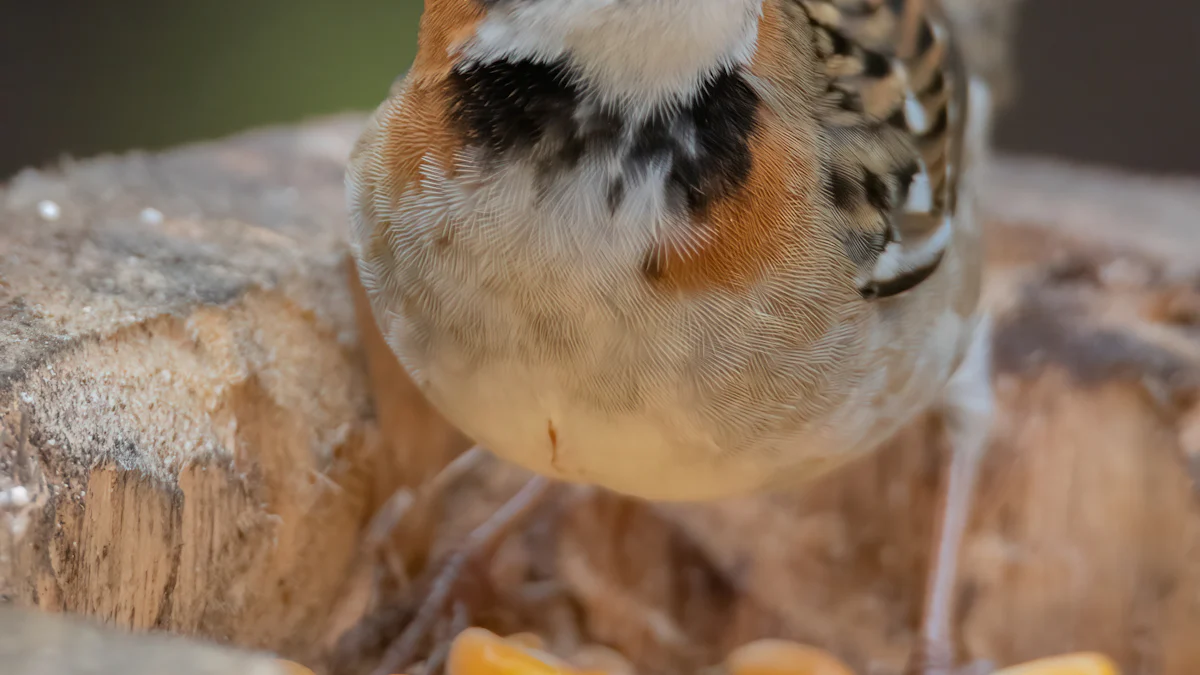
Mealworms stand out as a remarkable choice for animal feed, especially when sourced from a quality mealworms supplier. You benefit from their superior nutritional profile, rich in protein and essential amino acids. These tiny creatures offer more iron than sirloin beef, making them a powerhouse of nutrients. Mealworms also shine as a sustainable option. They require less land, water, and energy to produce, resulting in a minimal environmental footprint. Cultivating mealworms proves cost-effective, with lower resource consumption and reduced processing needs. By choosing mealworms from a quality mealworms supplier, you embrace an eco-friendly and efficient feed solution that supports both your animals and the planet.
Nutritional Benefits of Mealworms
High Protein Content
Mealworms offer an impressive protein content, making them a top choice for animal feed. You can rely on mealworms to provide the essential building blocks for growth and development in your animals.
Essential Amino Acids
Mealworms are packed with essential amino acids, which are crucial for maintaining the health and vitality of your animals. These amino acids support muscle growth, repair tissues, and enhance overall well-being. By incorporating mealworms into your feed, you ensure that your animals receive a balanced diet rich in these vital nutrients.
Protein Digestibility
The protein in mealworms is highly digestible, meaning your animals can efficiently absorb and utilize it. This digestibility ensures that the nutrients are effectively used, promoting better growth and health outcomes. You can trust mealworms to deliver the protein your animals need without the waste associated with less digestible feed options.
Rich in Vitamins and Minerals
Mealworms are not just about protein; they also provide a wealth of vitamins and minerals that contribute to a balanced diet.
Vitamin B12 and Iron
Mealworms are an excellent source of Vitamin B12 and iron, both of which are essential for maintaining energy levels and supporting the immune system. Vitamin B12 plays a key role in nerve function and the production of red blood cells, while iron is crucial for oxygen transport in the blood. By choosing mealworms, you give your animals a nutrient boost that supports their overall health.
Omega-3 and Omega-6 Fatty Acids
In addition to vitamins and minerals, mealworms contain beneficial omega-3 and omega-6 fatty acids. These healthy fats are important for maintaining heart health, reducing inflammation, and supporting brain function. Including mealworms in your animal feed ensures that your animals receive these essential fatty acids, promoting their long-term health and well-being.
By embracing mealworms as a feed option, you provide your animals with a nutrient-rich diet that supports their growth, health, and vitality.
Sustainability of Mealworms
Low Environmental Impact
Mealworms offer a sustainable solution for animal feed, significantly reducing your environmental footprint. Their production emits fewer greenhouse gases compared to traditional livestock farming.
Reduced Greenhouse Gas Emissions
When you choose mealworms, you contribute to a cleaner planet. Producing 1 kg of edible mealworm protein results in only 20.4 kg CO2-eq for global warming potential. This is a stark contrast to the emissions from conventional animal protein sources. By incorporating mealworms into your feed, you actively participate in minimizing greenhouse gas emissions.
Minimal Water Usage
Water conservation becomes effortless with mealworms. They require far less water than traditional livestock, making them an ideal choice for sustainable farming. You help preserve precious water resources by opting for mealworms, ensuring a more sustainable future for generations to come.
Efficient Feed Conversion
Mealworms excel in feed conversion efficiency, providing you with a high feed-to-protein ratio. This efficiency translates to less land and resources needed for their cultivation.
High Feed-to-Protein Ratio
Mealworms boast a remarkable feed-to-protein ratio, meaning they convert feed into protein more efficiently than many other animals. This efficiency ensures that you get more protein output for the same amount of feed input, optimizing your resources and reducing waste.
Less Land Requirement
Land usage becomes minimal with mealworms. They occupy only 22.38 m² for agricultural land occupation per kilogram of protein produced. This reduced land requirement allows you to maximize your farming space, making mealworms a practical choice for both small and large-scale operations.
By embracing mealworms as a sustainable feed option, you take a proactive step towards reducing environmental impact. You not only provide your animals with high-quality nutrition but also contribute to a healthier planet.
Cost-effectiveness of Mealworms
Lower Production Costs
Mealworms offer a cost-effective solution for animal feed production. You can achieve significant savings by utilizing mealworms, thanks to their inexpensive feed inputs and reduced labor costs.
Inexpensive Feed Inputs
Mealworms thrive on low-cost feed inputs. They consume organic waste and agricultural by-products, which are often cheaper than traditional feed ingredients. By choosing mealworms, you minimize feed expenses while maintaining high nutritional value for your animals.
Reduced Labor Costs
Raising mealworms requires less labor compared to conventional livestock. Their simple farming techniques and minimal maintenance needs translate to lower labor costs. You can allocate resources more efficiently, focusing on other aspects of your farming operations.
Economic Benefits for Farmers
Embracing mealworms as a feed option brings economic advantages to farmers. You can enjoy increased profit margins and tap into the growing market demand for sustainable feed.
Increased Profit Margins
Mealworms provide a high feed-to-protein ratio, ensuring efficient resource utilization. This efficiency leads to higher profit margins, as you get more protein output for the same input. By incorporating mealworms, you optimize your production processes and boost your bottom line.
Market Demand for Sustainable Feed
The demand for sustainable feed options is on the rise. Consumers and industries alike seek eco-friendly alternatives. By offering mealworms, you position yourself at the forefront of this trend, meeting market demands and attracting environmentally conscious customers.
"Mealworms can be farmed with less water, land, and energy while producing high-quality feed with fewer greenhouse gas emissions."
By choosing mealworms, you not only reduce costs but also contribute to a more sustainable and profitable farming future.
Ease of Cultivation
Simple Farming Techniques
Mealworms offer you a straightforward approach to farming. Their cultivation doesn’t require complex systems or high-tech equipment. You can easily manage their growth with basic resources.
Indoor and Outdoor Farming
You have the flexibility to farm mealworms both indoors and outdoors. This adaptability allows you to choose the best environment based on your available space and climate conditions. Indoor farming provides controlled conditions, protecting mealworms from harsh weather. Outdoor farming, on the other hand, utilizes natural resources, reducing energy costs.
Low Maintenance Requirements
Mealworms demand minimal maintenance. You don’t need to invest much time or effort in their care. They thrive on organic waste and agricultural by-products, which are readily available and inexpensive. This low-maintenance nature makes mealworm farming accessible to everyone, from hobbyists to commercial farmers.
Scalability for Large and Small Operations
Mealworm farming scales effortlessly, whether you’re running a small backyard operation or a large commercial farm. Their adaptability ensures that you can expand or reduce your production as needed.
Adaptability to Different Environments
Mealworms adapt well to various environments. You can raise them in different climates and conditions without significant changes to their habitat. This adaptability means you can start mealworm farming regardless of your location, making it a versatile option for diverse agricultural settings.
Quick Reproduction Cycle
Mealworms reproduce quickly, allowing you to increase your production rapidly. Their short life cycle means you can harvest them frequently, ensuring a steady supply of feed. This quick reproduction cycle supports your ability to meet growing demand and maximize your output efficiently.
"Mealworms can be farmed with less water, land, and energy while producing high-quality feed with fewer greenhouse gas emissions." – Mother Earth News
By embracing mealworm farming, you tap into a sustainable and efficient method of producing animal feed. You benefit from their ease of cultivation, ensuring a reliable and eco-friendly feed source for your animals.
Comparing Mealworms to Other Feed Options
Mealworms vs. Traditional Grains
Nutritional Superiority
When you compare mealworms to traditional grains, the nutritional benefits become clear. Mealworms boast a higher protein content than many grains, including soybeans. This makes them an excellent source of essential amino acids that your animals need for growth and health. While grains provide carbohydrates, mealworms offer a more balanced nutritional profile with proteins, healthy fats, and essential vitamins. By choosing mealworms, you ensure that your animals receive a diet rich in nutrients that support their overall well-being.
Environmental Advantages
Mealworms also shine in terms of environmental impact. They require significantly less water and land compared to grain production. This means you can reduce your ecological footprint by opting for mealworms over traditional grains. Additionally, mealworms produce fewer greenhouse gas emissions, contributing to a cleaner and more sustainable planet. By incorporating mealworms into your feed, you actively participate in preserving natural resources and promoting environmental health.
Mealworms vs. Fishmeal
Sustainability Benefits
Fishmeal has long been a staple in animal feed, but mealworms offer a sustainable alternative. You can grow mealworms using low-grade organic bioresources, reducing the strain on marine ecosystems. Unlike fishmeal, which relies on wild fish stocks, mealworms can be cultivated with minimal environmental impact. This makes them a more sustainable choice for your feed needs. By choosing mealworms, you support biodiversity and help protect ocean habitats.
Cost Comparisons
From a cost perspective, mealworms present an attractive option. They have a high feed conversion efficiency, meaning you get more protein output for the same input compared to fishmeal. This efficiency translates to lower production costs and increased profitability. You can achieve significant savings by incorporating mealworms into your feed, without compromising on quality or nutrition. As the demand for sustainable feed options grows, mealworms position you to meet market needs while optimizing your resources.
"Mealworms can be farmed with less water, land, and energy while producing high-quality feed with fewer greenhouse gas emissions." – Mother Earth News
By comparing mealworms to traditional grains and fishmeal, you discover their superior nutritional value, environmental benefits, and cost-effectiveness. Embracing mealworms as a feed option empowers you to make a positive impact on both your animals and the planet.
Practical Tips for Incorporating Mealworms into Animal Diets
Preparing Mealworms for Feed
Mealworms offer a high-protein, nutrient-packed option for animal diets. To maximize their benefits, you need to prepare them properly.
Drying and Grinding Techniques
Start by drying mealworms to preserve their nutritional value. You can use an oven or a dehydrator. Set the temperature to a low setting and dry them until they become crispy. This process ensures that the mealworms retain their nutrients while extending their shelf life. Once dried, grind them into a fine powder. This makes it easier to mix with other feed ingredients and ensures even distribution in the diet.
Mixing with Other Feed Ingredients
After grinding, combine mealworm powder with other feed ingredients. This creates a balanced diet for your animals. You can mix mealworms with grains, vegetables, or other protein sources. This combination provides a comprehensive nutritional profile, supporting the growth and health of your animals. By incorporating mealworms, you enhance the overall quality of the feed.
Recommended Feeding Practices
Incorporating mealworms into animal diets requires careful attention to feeding practices. This ensures optimal health and performance.
Optimal Feeding Ratios
Determine the right feeding ratios for your animals. Mealworms should complement the existing diet, not replace it entirely. Start by adding a small percentage of mealworm powder to the feed. Gradually increase the amount as your animals adjust. This approach allows you to monitor their response and make necessary adjustments. The goal is to provide a balanced diet that meets their nutritional needs.
Monitoring Animal Health
Keep a close eye on your animals’ health when introducing mealworms. Look for signs of improved growth, energy levels, and overall well-being. Mealworms are rich in amino acids, vitamins, and minerals, supporting overall health. Regular monitoring helps you identify any changes in behavior or health, allowing you to adjust the diet accordingly. By staying vigilant, you ensure that your animals thrive on their new mealworm-enriched diet.
"Mealworms are an excellent choice for animal nutrition due to their high protein content and balanced nutritional profile, reducing the environmental impact of traditional livestock farming." – National Center for Biotechnology Information
By following these practical tips, you can successfully incorporate mealworms into your animal diets. You provide a high-quality, sustainable feed option that supports the health and vitality of your animals.
Addressing Common Concerns
Safety and Hygiene
Ensuring the safety and hygiene of mealworms in animal feed is crucial. You must prioritize quality control and contamination prevention to maintain the health of your animals.
Ensuring Quality Control
Quality control begins with sourcing mealworms from reputable suppliers. You should verify that the supplier adheres to industry standards and regulations. Regular inspections and testing of mealworm batches help ensure they meet nutritional and safety requirements. Implementing a robust quality control system guarantees that your animals receive high-quality feed, free from harmful substances.
Preventing Contamination
Contamination prevention is vital in maintaining the integrity of mealworm feed. You should store mealworms in clean, dry environments to avoid mold and bacterial growth. Proper handling and storage practices minimize the risk of contamination. By following these guidelines, you protect your animals from potential health hazards and ensure their well-being.
Regulatory Considerations
Navigating regulatory considerations is essential when incorporating mealworms into animal feed. You must comply with feed standards and understand labeling requirements to ensure legal and safe usage.
Compliance with Feed Standards
Compliance with feed standards involves understanding regional, national, and international regulations. You should familiarize yourself with the specific requirements for mealworm feed in your area. Adhering to these standards ensures that your feed is safe and nutritionally adequate for your animals. By staying informed and compliant, you contribute to the responsible use of mealworms in animal nutrition.
Understanding Labeling Requirements
Labeling requirements play a crucial role in transparency and consumer trust. You must accurately label mealworm feed products, detailing their nutritional content and any additives. Clear labeling helps consumers make informed choices and ensures compliance with regulatory guidelines. By providing accurate information, you build trust with your customers and promote the responsible use of mealworms in animal feed.
"Producers must adhere to regional, national, and international regulations to assure product safety and nutritional value." – Regulations for Mealworm Industry Expansion
By addressing these common concerns, you ensure the safe and effective use of mealworms in animal feed. You protect your animals’ health, comply with regulations, and contribute to a sustainable and responsible feeding practice.
Finding a Quality Mealworms Supplier
Finding a quality mealworms supplier is crucial for ensuring the best feed for your animals. You need to evaluate potential suppliers carefully to make informed decisions that benefit both your farm and your animals.
Evaluating Supplier Credentials
When searching for a quality mealworms supplier, you should start by evaluating their credentials. This step ensures that you partner with a reputable source that meets industry standards.
Certifications and Standards
Look for suppliers who hold relevant certifications and adhere to industry standards. Certifications indicate that the supplier follows best practices in mealworm production. For example, companies like Ÿnsect have developed high-quality mealworm products with exceptional nutritional properties. These certifications guarantee that the mealworms you receive are safe, nutritious, and produced sustainably.
Customer Reviews
Customer reviews provide valuable insights into a supplier’s reliability and product quality. You should read reviews from other farmers and businesses who have used the supplier’s mealworms. Positive feedback and high ratings suggest that the supplier consistently delivers quality products. By considering customer reviews, you gain a better understanding of what to expect from the supplier.
Ensuring Consistent Supply
A consistent supply of mealworms is essential for maintaining a steady feed source for your animals. You must assess the supplier’s ability to meet your needs reliably.
Supplier Reliability
Reliability is key when choosing a mealworms supplier. You should inquire about their production capacity and delivery schedules. Companies like Protix B.V. and BETA HATCH are known for their robust supply chains and consistent delivery. A reliable supplier ensures that you never run out of mealworms, keeping your animals well-fed and healthy.
Delivery Options
Consider the delivery options offered by the supplier. Flexible delivery schedules and multiple shipping methods can accommodate your specific requirements. You should choose a supplier who can deliver mealworms promptly and efficiently, minimizing any disruptions to your feeding routine. By selecting a supplier with reliable delivery options, you ensure a seamless integration of mealworms into your animal feed program.
"Prominent players in the mealworms market include Protix B.V., Ÿnsect SAS, BETA HATCH, Armstrong Crickets Georgia, TEBRIO, Tebrito AB, Entec Nutrition, Invertapro AS, Keil Co., Ltd, EntoBreed Farming BV, and Goterra."
By carefully evaluating supplier credentials and ensuring a consistent supply, you secure a reliable source of high-quality mealworms. This choice supports your animals’ health and contributes to a sustainable and efficient farming operation.
Mealworms offer you a nutritious, sustainable, and cost-effective feed option. Their high protein content and rich supply of essential vitamins and minerals make them a valuable addition to any animal diet. You can easily cultivate mealworms using low-grade organic bioresources, reducing your environmental footprint. They integrate seamlessly into existing feeding practices, providing a viable alternative to traditional animal feed. By exploring options with a quality mealworms supplier, you ensure the best results for your animals and contribute to a more sustainable future.


